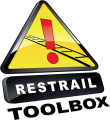Advanced search
Selected keywords: Suicide
Search results17
| Family |
|---|
| Risk assessment This family of measures includes a number of different ways in which an organisation or the railway industry identifies risks in normal or special circumstances. This is an underpinning measure which supports decision-making and targeting of other measures. It is considered an organisational (...) |
| Learning from best practice This family of measures includes different ways in which a railway organisation or decision-maker can improve their knowledge and skills regarding suicide and trespassing prevention. This is an underpinning measure which supports decision-making and targeting of other measures. It can also (...) |
| Collaboration between organisations This family of measures includes national partnerships as well as local ones (e.g. linked to a specific route or geographical area) to produce better joint working between a range of organisations and agencies. These measures underpin or support the implementation of many other measures. The (...) |
| Societal collaboration to prevent railway suicide This family concerns the close collaboration between different concerned actors in order to stop the railway traffic before an incident happens. The service that first becomes aware of a potential incident request and receives a temporary traffic shut down. The aim is to create good conditions (...) |
| Information sharing at regional level This family concerns the surveillance of individuals at risk based on intelligence about those at risk and knowledge of high risk locations. The principle is that there is a system or an organisation that can provide an alarm to somebody that the concerned person is approaching the tracks. It (...) |
| Patrols and enforcement This family of measures consists of visible surveillance performed by special security patrols to deter access to high risk areas, to enforce the law and to intervene when potential incidents are identified. It is considered a dissuasive family because it is aimed to detect and discourage (...) |
| Fences at stations This family of measures consists of access restriction or limitation by fences and other physical barriers at specific parts of stations to prevent unauthorised access to the rails. It is considered a physical family because it physically influences the accessibility and potential collision, (...) |
| Fences outside stations This family of measures consists of access restriction or limitation by fences and other physical barriers at high risk locations outside stations (i.e. hotspots) to prevent unauthorised access to the rails. It is considered a physical family because it physically influences the accessibility (...) |
| Landscaping This family consists of access restriction or limitation by natural physical barriers at specific parts of stations to prevent unauthorised access to the rails. It can equally involve shaping the terrain or the vegetation in a particular area in order to enhance the visibility or the movement (...) |
| Detection and surveillance systems This family of measures consists of technologies aimed to influence the person at risk and to facilitate the surveillance process. The goal of intelligent surveillance systems is to provide an automated early detection and to send a form of alert in real time to the person at risk or to the (...) |
| Lighting devices to influence behaviour This family of measures consists of lighting technologies aimed to influence the person at risk of suicide and occasionally to facilitate the surveillance process. It is considered a technological family because it uses lighting technologies to with the aim to discourage people with suicide (...) |
| Light to increase visibility at hotspots This family consists of lighting technologies aimed to influence the persons at risk of suicide by increasing their visibility, self-awareness and by facilitating surveillance and detection. It is considered a technological family because it uses lighting technology to enhance the surveillance (...) |
| Safety and emergency devices at stations This family of measures consists of emergency devices, information and contact arrangements to enable rapid intervention when problems occur. This information is usually displayed at stations posters, signs, screens, billboards etc. to provide passengers or bystanders the information on what to (...) |
| Campaigns to raise awareness This family consists of campaign measures which can be defined as any purposeful attempts to inform, persuade and motivate a targeted subgroup of the population to change its attitudes and/or their behaviours to improve rail safety, using organised communications, involving specific media (...) |
| Mass media campaigns This family consists of campaign measures which can be defined as any purposeful attempts to inform, persuade and motivate a targeted subgroup of the population to change its attitudes and/or their behaviours to improve rail safety, using organised communications, involving specific media (...) |
| Media guidelines This family of measures consists of interventions which attempt to optimise the communication about suicides in order to promote correct and ethical information about the phenomenon, as well as to avoid contagion effects. It is considered an educational family because it is concerned with the (...) |
| Training to prevent suicide This family consists of training programs dedicated to railway personnel at railway stations or other locations where the staff may be present, in order to identify and approach people at high risk for suicide. It is considered an educational family because it teaches the railway staff how to (...) |

